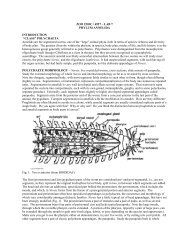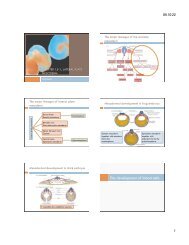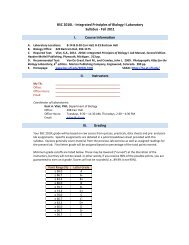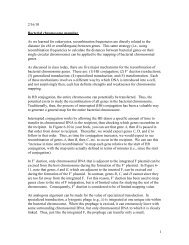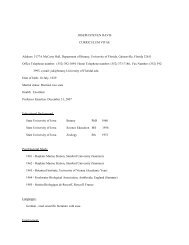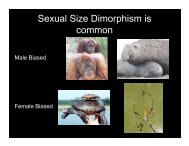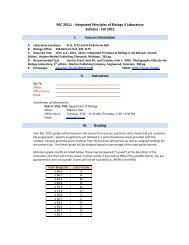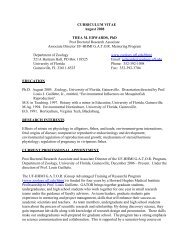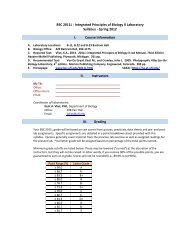Lecture Notes 7: Annelida
Lecture Notes 7: Annelida
Lecture Notes 7: Annelida
Create successful ePaper yourself
Turn your PDF publications into a flip-book with our unique Google optimized e-Paper software.
- budding as preamble to sexual reproduction: epitokes. Epitokes are morphologically-modified stages that are<br />
budded off the rear of the vegetative worm. E.g. eunicids - palolo worms budded off parent, which stays in<br />
substratum, hind end swims off. Swarms 7 th day after 1 st full moon following autumn equinox. Swarms so<br />
large in Fiji / Samoa that they are harvested for food! Spaghetti nights on coral spawning nights!<br />
- heteronereids – not epitokes – whole worm metamorphoses into swarmer. Body wall muscles change, gut<br />
resorbed, parapodia and chaetae become modified for more effective swimming, especially toward posterior<br />
end of worm. (pretty distinct posterior – anterior differentiation in Platynereis dumerilli and Nereis vexillosa,<br />
but not much separation in Neanthes brandti).<br />
- gonads: peritoneal, primitive metazoan condition. Gametes mature in coelom and released either through<br />
gonoducts or by disintegration of worm (e.g. in nereids – body rupture).<br />
Development:<br />
Spiralian, schizocoelous protostomes.<br />
Trochophores<br />
Some brood – e.g. sabellid tube brooding<br />
Ecology & Diversity:<br />
Scolecida<br />
Palpata<br />
- Aciculata<br />
- Canalipalpata<br />
SCOLECIDA<br />
- tend to have “simple axial buccal organs”, i.e., short, eversible, pad-like pharynxes used for deposit feeding,<br />
eversion driven by coelomic pressure, thus tendency of families to have lost septa in anterior segment to allow<br />
this, muscular retraction.<br />
- mostly unselective, burrowing deposit feeders, without head appendages, free living (though some maldanids<br />
make sandy tubes).<br />
Arenicolidae<br />
- J-shaped tube, surface dimple, eat organic rich accumulations; fecal casts<br />
- burrow irrigation<br />
Maldanidae<br />
- tube-dwelling deposit feeders; live head down in tube, gobble sediment. Simple axial buccal organ like<br />
arenicolids. Nor all have tubes, but local Axiothella does, tube of poorly agglutinated, thick layer of sediment.<br />
Common in mid False Bay<br />
Capitellidae<br />
- burrowing, free-living sediment ingestors - earthworms of sea<br />
PALPATA – ACICULATA<br />
- well-defined clade with many synapomorphies, most strikingly the acicula, antennae, well developed parapodia<br />
Onuphidae<br />
- tube building omnivores<br />
- sister to Eunicidae, very similar, except build parchment tube (which come carry around), and has ceratophores on<br />
antennae and palps.<br />
- palps antenniform, so with 3 antennae end up with 5 similar “tentacles” on head<br />
- Diopatra lunge out at prey from parchment tube<br />
- pair of peristomial cirri on peristomium behind prostomium – unique to Eunicidae-Onuphidae<br />
- many with large, well developed dorsal gills in anterior segments (good for respiration in tube-confines)<br />
Eunicidae





